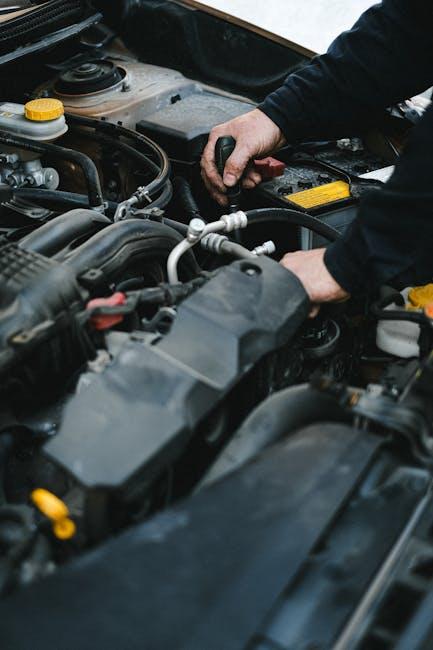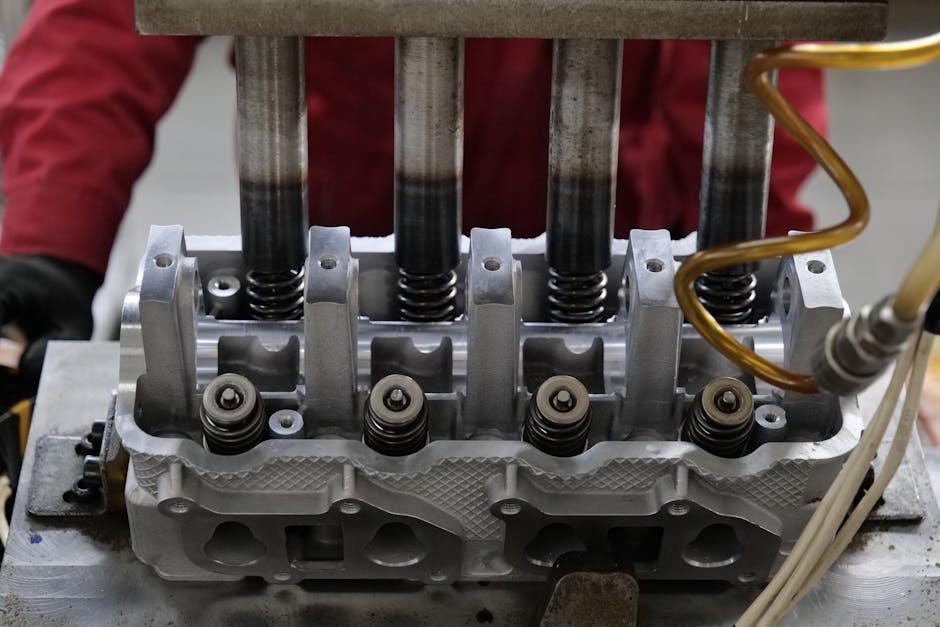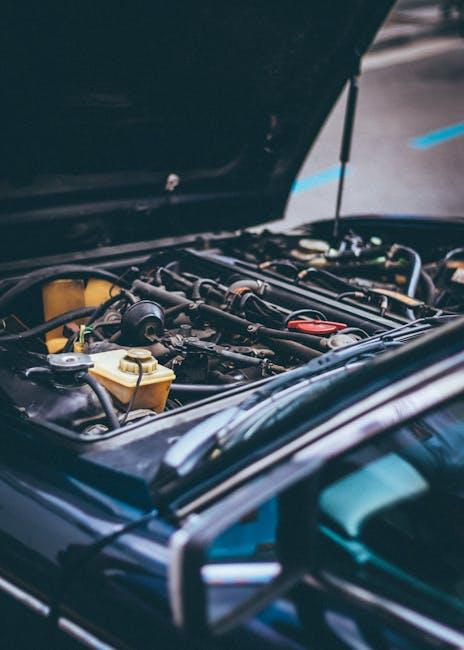In the intricate dance of gears, wires, and moving parts that powers our vehicles, regular tune-ups serve as the quiet choreographers, ensuring every component moves in harmony. Just as a well-rehearsed routine prevents missteps on stage, these scheduled maintenance sessions keep our cars running smoothly and alert us to potential issues before they escalate. This article explores how regular tune-ups act not only as a preventative shield against unexpected breakdowns but also as an investment in reliability and peace of mind on every journey.
Table of Contents
- The Hidden Benefits of Routine Tune-Ups for Vehicle Longevity
- Identifying Early Warning Signs Through Professional Inspections
- Optimizing Engine Performance with Preventive Maintenance
- Essential Tune-Up Tasks That Reduce the Risk of Unexpected Breakdowns
- Cost-Effective Strategies for Scheduling Regular Vehicle Check-Ups
- Expert Tips for Maintaining Your Car Between Tune-Up Appointments
- Q&A
- To Wrap It Up

The Hidden Benefits of Routine Tune-Ups for Vehicle Longevity
Regular tune-ups act as a silent guardian for your vehicle, catching issues before they morph into costly repairs. Through meticulous inspection and adjustment, technicians optimize engine performance, ensuring every component functions harmoniously. This proactive care can dramatically reduce the risk of unexpected breakdowns, saving you from inconvenient and often expensive roadside emergencies. Moreover, it restores fuel efficiency and maintains smooth acceleration, enhancing your daily driving experience without interruptions.
Key advantages of consistent tune-ups include:
- Early detection of worn-out parts such as spark plugs and filters
- Improved fuel economy through optimal engine calibration
- Reduced emissions by maintaining cleaner combustion
- Extended lifespan of essential components like the battery and belts
| Tune-Up Component | Benefit | Typical Replacement Interval |
|---|---|---|
| Spark Plugs | Prevents misfires and rough idling | 30,000 – 60,000 miles |
| Air Filter | Enhances engine breathing and efficiency | 15,000 – 30,000 miles |
| Fuel Filter | Maintains clean fuel flow to engine | 30,000 – 40,000 miles |
| PCV Valve | Reduces engine sludge buildup | 50,000 – 70,000 miles |

Identifying Early Warning Signs Through Professional Inspections
Professional inspections serve as the first line of defense against unexpected vehicle breakdowns. Trained technicians utilize their expertise to spot subtle irregularities that often go unnoticed by everyday drivers. Early signs such as minute wear on belts, abnormal fluid discoloration, or unusual tire tread patterns can indicate developing issues that, if left unaddressed, escalate into costly repairs. These expert evaluations provide a detailed snapshot of your vehicle’s health, allowing for targeted tune-ups that reinforce overall reliability and performance.
During an inspection, professionals thoroughly examine critical components, including:
- Engine diagnostics for hidden faults
- Brake system wear and responsiveness
- Fluid levels and quality to prevent overheating or corrosion
- Electrical systems to avoid sudden failures
This proactive approach not only minimizes the risk of roadside emergencies but also extends the lifespan of your vehicle. Below is a comparison showing the frequency of issues detected in professional inspections versus self-checks:
| Inspection Type | Issues Detected | Preventive Repairs Made |
|---|---|---|
| Professional Inspection | 85% | 78% |
| Self-Checks | 40% | 22% |

Optimizing Engine Performance with Preventive Maintenance
Keeping your engine in peak condition goes beyond simply fixing issues when they arise. Preventive maintenance is the secret weapon that minimizes wear and tear, ensuring your vehicle runs smoothly and efficiently over time. Regular checks help identify subtle problems before they escalate, such as clogged air filters or deteriorating spark plugs, which can significantly impact fuel economy and engine responsiveness.
In practice, a well-maintained engine benefits from:
- Improved combustion efficiency—leading to cleaner exhaust and better mileage.
- Reduced risk of overheating—thanks to timely coolant system inspections.
- Longer lifespan for essential components like belts and hoses.
Scheduling routine tune-ups ensures that the mechanical harmony of your engine remains uninterrupted, preventing costly repairs and unexpected breakdowns down the road.
| Maintenance Task | Frequency | Benefits |
|---|---|---|
| Oil & Filter Change | Every 5,000 – 7,500 miles | Lubricates engine and removes contaminants |
| Spark Plug Replacement | Every 30,000 – 50,000 miles | Ensures optimal ignition and power |
| Air Filter Inspection | Every 15,000 miles | Improves airflow and fuel efficiency |

Essential Tune-Up Tasks That Reduce the Risk of Unexpected Breakdowns
Regularly tuning up your vehicle isn’t just about maintaining performance—it’s a strategic way to dodge unexpected breakdowns that can disrupt your day. During a thorough tune-up, several critical components are inspected and fine-tuned to keep your engine running smoothly. This includes checking spark plugs, replacing worn-out filters, inspecting belts and hoses, and ensuring fluid levels are optimal. Each task may seem small, but together they form a defensive shield against costly roadside emergencies.
Here are some key tasks that significantly reduce mechanical failures:
- Spark plug replacement: Prevents misfires and improves fuel efficiency.
- Air and fuel filter cleaning: Ensures clean air and fuel delivery, reducing engine strain.
- Fluid top-offs: Maintains cooling and lubrication systems.
- Belt and hose inspection: Detects wear before breakage causes engine breakdown.
| Task | Benefit | Typical Interval |
|---|---|---|
| Spark Plug Replacement | Improves ignition | Every 30,000 miles |
| Air Filter Change | Enhances airflow | Every 15,000 miles |
| Coolant Level Check | Prevents overheating | Annually |
| Belt and Hose Inspection | Avoids sudden failures | Every 20,000 miles |

Cost-Effective Strategies for Scheduling Regular Vehicle Check-Ups
Maintaining your vehicle with regular check-ups doesn’t have to drain your wallet. One of the smartest ways to stay on top of maintenance is by creating a personalized schedule based on your driving habits and vehicle model. Utilize mobile apps or calendar reminders to keep appointments consistent, ensuring that essential services like oil changes, brake inspections, and fluid top-offs happen before small issues snowball into costly repairs. Pair this with purchasing maintenance packages or memberships from trusted local garages that offer discounted rates for routine services — it’s a win-win for your car’s health and your savings.
Additionally, practicing simple DIY inspections between professional visits can extend the longevity of your vehicle’s components. Keep an eye on tire pressure, check for fluid leaks, and listen for unusual engine noises. These quick checks can help you detect early warning signs and prioritize your shop visits effectively. Here’s a quick guide to help balance cost and care:
| Strategy | Benefit | Cost Impact |
|---|---|---|
| Scheduled Tune-Ups | Prevents major mechanical failures | Moderate routine costs |
| DIY Inspections | Early detection of issues | Minimal to no cost |
| Maintenance Packages | Discounted bulk services | Lower per-service fees |
| Use Reminder Apps | Ensures regular service intervals | Free to low cost |

Expert Tips for Maintaining Your Car Between Tune-Up Appointments
Keeping your vehicle in prime condition doesn’t stop at the mechanic’s shop. Simple, consistent care efforts can dramatically stretch the intervals between tune-up visits. Prioritize checking fluid levels—engine oil, brake fluid, and coolant—to safeguard your engine’s core functions. Also, inspect your tire pressure regularly; proper inflation improves fuel efficiency and reduces wear and tear. Your car’s lifespan relies heavily on these small, proactive measures that often get overlooked but are crucial in preventing unexpected breakdowns.
Additionally, pay attention to your car’s response while driving. Unusual noises, sluggish acceleration, or warning lights are subtle hints demanding immediate attention. Incorporate a quick, routine cleaning of air filters and replace windshield wipers seasonally to maintain visibility and engine performance. Below is a quick maintenance checklist you can follow between professional tune-ups:
- Check and top off fluids (oil, brake, transmission, coolant)
- Inspect tire pressure and tread monthly
- Listen for odd sounds and unusual vibrations
- Clean or replace air filters every 12,000 miles
- Replace windshield wipers every 6-12 months
| Task | Frequency | Benefit |
|---|---|---|
| Oil Level Check | Monthly | Engine Longevity |
| Tire Pressure | Monthly | Fuel Efficiency |
| Air Filter Cleaning | Every 12,000 miles | Performance Optimization |
| Wiper Replacement | Every 6-12 months | Clear Visibility |
Q&A
Q&A: How Regular Tune-Ups Prevent Breakdowns
Q: What exactly is a tune-up, and why does it matter?
A: Think of a tune-up as a health check for your vehicle. It’s a comprehensive inspection and maintenance session that adjusts, replaces, or cleans key components like spark plugs, filters, and fluids. By fine-tuning these parts, your car runs smoothly and efficiently—much like a well-oiled machine.
Q: How do tune-ups actually help prevent breakdowns?
A: Tune-ups catch small issues before they snowball into big problems. For example, worn spark plugs can cause misfires, leading to stalled engines. Dirty filters reduce airflow, stressing your engine. Regular tune-ups fix these quirks early, keeping your vehicle reliable and minimizing the risk of sudden, inconvenient breakdowns.
Q: Can tune-ups improve my vehicle’s performance, or are they just about avoiding failures?
A: They do both! Beyond preventing breakdowns, tune-ups optimize engine performance, enhancing fuel efficiency, smoother acceleration, and cleaner emissions. It’s a win-win situation—your car not only stays on the road but runs better while doing so.
Q: How often should I schedule a tune-up?
A: While recommendations vary by make and model, a general rule is every 30,000 miles or once a year. However, if you notice warning signs like rough idling, decreased fuel economy, or dashboard alerts, it’s smart to get a tune-up sooner.
Q: Are tune-ups worth the time and money?
A: Absolutely. Investing in regular tune-ups can save you from costly repairs down the line. It’s far less expensive to replace a set of spark plugs than to fix engine damage caused by neglect. Plus, you gain peace of mind knowing your vehicle won’t leave you stranded unexpectedly.
Q: Can I perform tune-ups myself, or should I visit a mechanic?
A: Some basic tune-up tasks, such as replacing air filters or spark plugs, can be done at home if you’re comfortable with DIY car care. However, comprehensive tune-ups involving diagnostics and precise adjustments are best handled by professional mechanics equipped with the right tools and expertise.
Q: What’s the biggest takeaway about tune-ups and breakdown prevention?
A: Regular tune-ups are proactive steps that keep your vehicle healthy and dependable. They transform your car from a ticking time bomb of potential failures into a trusty companion ready to take you wherever you need to go—without unexpected interruptions.
To Wrap It Up
In the rhythm of everyday driving, your vehicle’s tune-up is the unsung conductor, harmonizing each component to perform its best. By investing a little time and care into regular maintenance, you’re not just preventing unexpected breakdowns—you’re extending the life of your car and ensuring every journey is smooth and reliable. Consider tune-ups as the vital check-ins that keep your automotive story running without a hitch, turning potential roadblocks into mere bumps in the road. After all, a well-tuned engine is the secret to worry-free adventures ahead.
